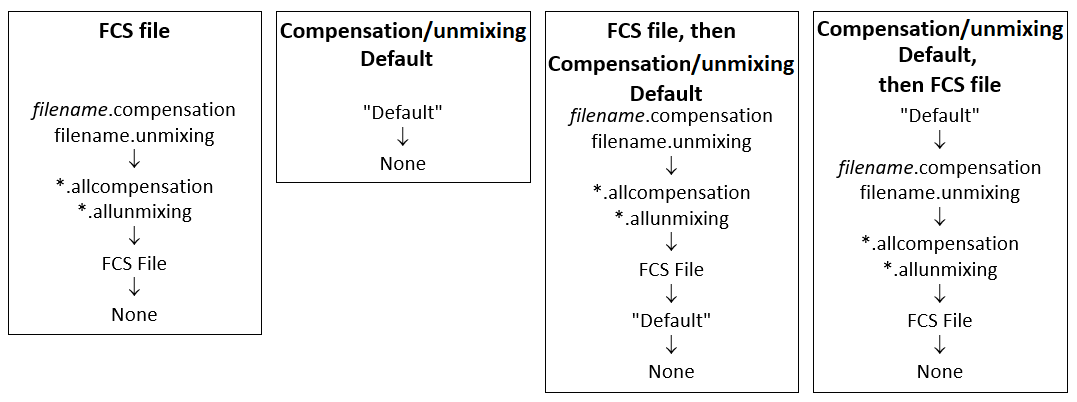Selecting the Default Definiton to Use When Loading Data
FCS Express has many default options for applying compensation when loading new data files or adding plots to your layouts. The default options for compensation/unmixing definition are described in the table below.
Option |
Explanation |
|---|---|
None |
When adding a new plot, no definition will be used. When changing a file on an existing plot, the definition that was applied to the plot before the change will continue to be used. |
Compensation/Unmixing Default |
The Compensation/unmixing definition that was manually "Set as Default" will be used. To set the definition "as Default", please see the Using Definiton Matrices chapter. |
FCS File |
The definition stored with the file is automatically used when the data file is displayed on a plot. This is commonly the compensation matrix defined at the time of acquisition (for FCS 3.0 or later format files), or it may be a compensation/unmixing that was Assigned to an .fcs file by FCS Express. |
FCS File, then Compensation/Unmixing Default |
See FCS File, above. However, if there is no FCS file definition, the definition "Set as Default" (see above) will be applied. |
Compensation/Unmixing Default, then FCS File |
See Compensation/Unmixing default above. However, if there is no definition "Set as Default", the FCS file definition (see above) will be automatically loaded. |
Understanding the Default Options in FCS Express
The definition default options can be setup differently for new layouts versus existing layouts. These two options provide you with the flexibility to define how your compensation/unmixing is applied when first loading your data and plots onto a new layout and the ability to change how compensation/unmixing is applied to new data files and plots added to an existing layout at any time.
For new layouts, you can define the compensation/unmixing default options from the User Options. These options are found on the General page of the Options dialog (File tab→Options) in the Compensation/Unmixing to use in new layouts drop-down list. Changes to the Default Compensation/Unmixing to Use at the User Options level will only apply to newly created layouts, and will not change how compensation/unmixing is applied to data and plots added to an existing layout.
Common use-cases for changing the Default Compensation/Unmixing to Use at the User Options level are:
•to ensure all new layouts load compensation/unmixing in the same way - i.e. you can set by default whether compensation/unmixing saved to a file or layout is applied or to have no compensation/unmixing applied at all.
•to prevent compensation/unmixing from being applied inappropriately - i.e. after creating a compensation/unmixing from single stained controls in FCS Express (see Automatic Compensation) and setting that compensation/unmixing as the default on the layout (see Using Compensation Matrices), you can ensure the default compensation/unmixing will be used on all new files loaded in for analysis rather than the compensation/unmixing saved to the fcs file.
For existing layouts, you can define the compensation/unmixing default options from the Layout Options (Figure 9.65). These options are found on the Layout Options page within the Layout Options dialog (File tab→Info→Layout Options) in the Compensation/unmixing to use in this layout drop-down list. These changes at the Layout Options level apply immediately to any new file or plot added to your analysis and will supersede the compensation/unmixing default options set in the User Options. Note that changes at the Layout Options level will not change the compensation/unmixing applied for any files and plots already present on the layout.

Figure 9.65. Layout Options - Changing the compensation default options (Default Compensation to Use).
Changing the compensation/unmixing default options at the Layout Options level is the recommended method to control how compensation/unmixing is applied to your data unless you are creating a brand new layout, in which case the User Options settings will apply. For new layouts, note the compensation/unmixing default options in the Layout Options will match those in the User Options by default.
Understanding How FCS Express Applies Compensation
FCS Express applies compensation/unmixing to your data files when they are first loaded into the layout (not just in the Data List). Understanding how FCS Express decides which compensation/unmixing to apply and when to use each option for loading compensation/unmixing is described in the table and image below (Figure 9.66).

Figure 9.66 Decision tree used by FCS Express to apply compensation or unmixing to your data based on user selected options.
